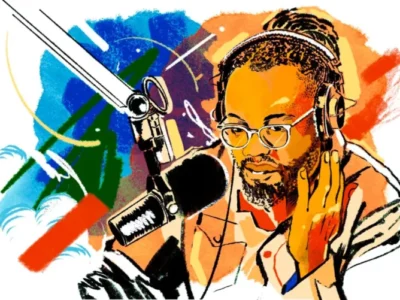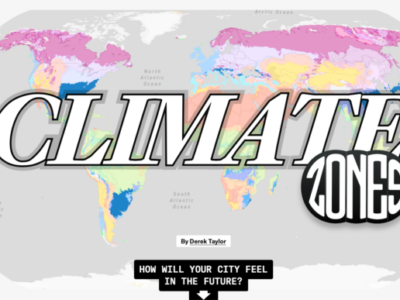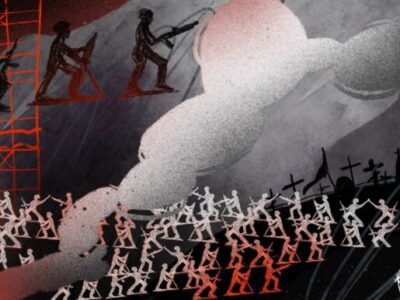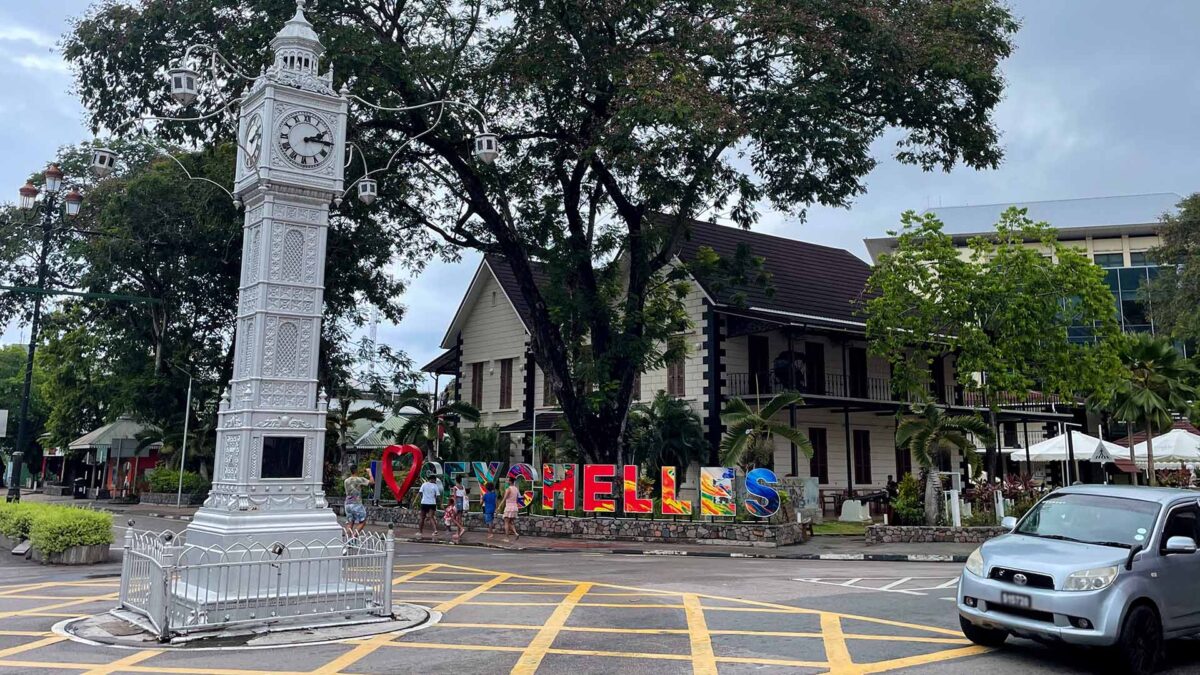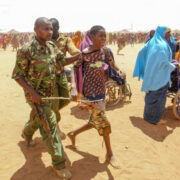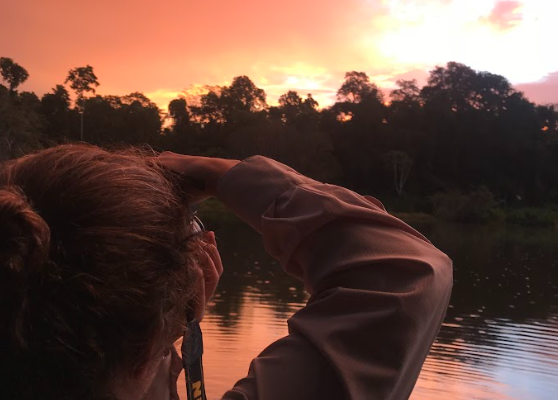
As an enduring rainforest paradise that has repelled pirates and traders, the island of Nosy Mangabe, on the east coast of Madagascar, is the perfect end-goal inspiration for a global news outlet at the frontline of environmental damage.
Mongabay — which honors that island with its name — recently celebrated 25 years of impactful watchdog reporting on forests, climate, and endangered ecosystems, as well as its growth to a dozen languages and more than five million monthly readers.
And the island’s native aye-aye lemur is perhaps the perfect symbol for the outlet’s network of investigative journalists and their collaborative partners who fearlessly hold environmental bad actors accountable. That’s because this lemur has sharp teeth that never stop growing; it loudly broadcasts its digging for all to hear — and it wields a famously long middle finger…
Begun as an environmental news blog by its founder, Rhett Butler, “in his pajamas,” the nonprofit Mongabay remains an entirely remote enterprise, with no offices at all — but now has about 110 editorial staff in five regional bureaus, and about 1,000 contributors spread across 80 countries.
A GIJN member organization, Mongabay is not an advocacy group, but is rather, according to its About page, “one of the top sources of environmental news, analysis, information, and inspiration on the internet,” which deliberately prioritizes coverage “in regions facing acute socio-environmental threats.”
“Part of what makes Mongabay unique is that we’re focussed primarily internationally on environmental issues, rather than in a local market, and the fact that we’re also multilingual,” says Butler.
Its latest major investigation, a collaboration with Earth Genome titled Los vuelos de la muerte (“The flights of death”), uncovered 67 clandestine air strips used by drug traffickers in the Peruvian Amazon, and the links between organized crime there and the killing of more than a dozen Indigenous leaders. Led by the Mongabay Latam bureau, the investigation included more than 60 interviews, physical visits, satellite imagery, and a custom-made AI search tool.
“We chose three regions there — Ucayali, Huánuco, and Pasco — because 15 Indigenous leaders have been killed and 28 are under threat since the pandemic began,” explains Alexa Eunoé Vélez Zuazo, Mongabay Latam’s managing editor. “We were able to confirm that these 67 airstrips are used to transport drugs, mainly to Bolivia and Colombia. The 56 illegal airstrips are located in and around Indigenous territories, and 10 airstrips have invaded forest concessions, where the forest should be harvested in a sustainable way.”
Andrew Revkin, an environmental reporter who produced award-winning investigations for The New York Times and ProPublica, says Mongabay is unique for its ability to have audience and policy impact within the countries at greatest risk of environmental damage.
“There is simply no journalistic enterprise with Mongabay’s ability to tell stories from the ground up, from Indonesia to India to Amazonia and beyond,” says Revkin, who was also the founding director of the Initiative on Communication and Sustainability at Columbia University’s Climate School. “Its translation program ensures stories reach people in the languages they use most, and free of charge via its Creative Commons license.” Revkin adds that another secret to the outlet’s local impact is that its simplified web design “ensures the articles will load on older devices in regions where Internet access may be limited.”
Reporting Widely, Digging Deeply
A glance at Mongabay’s global home page reveals an unmatched diversity of environmental reporting topics: from the fossil fuel threat to coral biodiversity and capital for climate financing to the human disease benefits of bobcat conservation and investigations into Ecuadorian gold mining and Indonesian palm oil.
Another element that distinguishes the organization is its consistent, in-depth focus on Indigenous communities around the world, including investigations into otherwise hidden cases of exploitation, improper natural resource extraction, biodiversity degradation, human rights abuse, and climate change impacts.
Mongabay also produces about a dozen major investigations annually, through dedicated investigators, watchdog beat reporters, and contributors. (See a highlights list of a single year of Mongabay investigations at this link). Some of the outlet’s more modest environmental investigations lead to bigger stories on human rights abuses, and some leads work the other way around. For instance, one 2021 investigation into the exploitation of Indonesian sailors by a partially state-owned Chinese tuna fleet subsequently exposed a massive, illegal shark finning practice in 2022.
“That was only uncovered because of all those interviews with the deck hands — you wouldn’t have gotten it any other way,” Butler recalls. Mongabay found that illicit shark fishing by a single Chinese company accounted for more than China’s total claim of sharks caught in the Western Pacific by all of its fleets combined.
Another major source of leads is the automated alerts the team receives from satellite image-based platforms, such as Global Forest Watch. If it flags a change in a vulnerable forest, reporters — and sometimes Butler himself — try to visit that spot, and investigate who or what caused it.
“Satellite access has been a game-changer for the kind of reporting we do. We’ve produced over 1,000 stories now using satellite imagery,” he says. “We use Global Forest Watch very heavily, because it’s linked in with a Planet layer and a land history layer. It also helps with fact-checking, as sources will tell us something, and we can then check on GFW to see the history of the land.”
Complex Model with Step-By-Step Expansion
Mongabay’s structural evolution has been a complicated story. It slowly transitioned from an ad-based outlet to a nonprofit organization eight years ago, and from a Facebook-oriented social media strategy based on click traffic to more audience-targeted outreach that emphasizes time-on-page and impact. Butler says both of these shifts automatically deepened the outlet’s investigative focus and impact.
“Our sites themselves of course represent our primary channel,” he says. “On social media, our most important platform now is LinkedIn — it’s our top platform for global English; it’s also the highest quality platform for content. Bureaus also have their own strategies. So for example, one of the target user groups for Mongabay Indonesia is youth, which is like half the population there. So they have an Instagram and TikTok approach.”
Investigations are treated differently than news and features, as editors actively try to raise awareness of their findings with local audiences beyond Mongabay’s readers. Where possible, they look for local reporters to collaborate.
“If we do an investigation, we’ll put effort in to find a local partner to co-publish the story, or be an investigative partner,” he explains. It launched its first regional bureau — including a managing editor and dedicated staff — in Indonesia, and has since rolled out other similar bureaus in India, Latin America and, at the end of 2023, Africa.
“Each of our five bureaus [which include its worldwide desk, plus regional desks in India, Indonesia, Latin America, and Africa] range in size from 10 to 20 people, and then the global bureau is the largest entity,” Butler explains. “A bureau is an autonomous unit with a manager, a social media person, and a newsroom that can be rapidly scaled up, as well as an investigative desk that pursues investigations both internally and also with outside contributors.”
He adds: “Everything lives in the global bureau till it gets big enough to spin off into its own bureau. For example, we’re incubating Mongabay Brazil currently, since it does not yet have enough resources to be a full bureau.” Still, the fledgling site was just recognized by Brazil’s National Federal Prosecutor’s Journalism Prize for its multi-year series “Palm Oil War.”
Mongabay’s funding comes from a mix of institutional and private donors, and it has a preliminary 2025 budget of about US$8.5 million.
“Typically, starting a bureau requires multiple funders who have a high likelihood of providing multiple years of funding — typically foundations,” Butler explains. “To provide a concrete example, once we’re able to reliably secure about US$500,000 a year, we would establish Mongabay Brazil as a bureau. That would cover staffing, a reporting fund for contributors, and other costs. Mongabay Indonesia’s 2024 budget — Indonesian-language only — is about US$400,000.”
Mongabay Latam’s Investigative Approach
Since its founding in 2016, investigations by the Mongabay Latam bureau have won the Inter American Press Association’s Journalistic Excellence Award (2023), the King of Spain Award (2019), and high-profile recognition from national competitions in Bolivia, Peru, Ecuador, Chile, and Mexico.
Vélez Zuazo says the “big bet” the autonomous bureau made was to invest in collaborations with regional outlets throughout the region to deepen investigative impact and boost the republication of content.
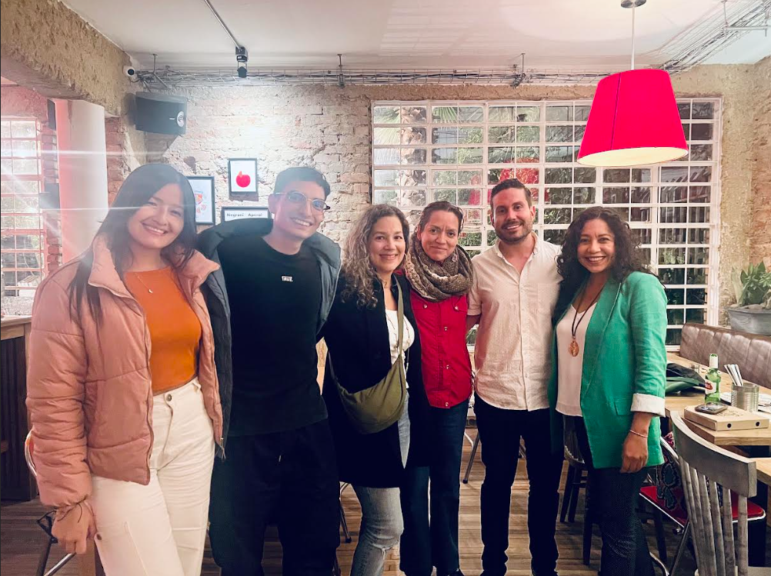
Six members of the Mongabay Latam team (left to right): Dalia Medina (social media coordinator), Richard Romero (multimedia coordinator), Alexa Eunoé Vélez Zuazo (managing editor), Dora Montero (fellowship Spanish editor), Antonio Paz (senior editor) and María Isabel Torres (director). Image: Courtesy of Mongabay
“To date, we have about 50 allies in the region,” she says. “We cover environmental news 24/7, so ideas come from receiving key information from journalistic sources, from finding angles or methodologies in a scientific paper that can help us better understand a problem.”
She adds: “We use classic journalistic methods combined with the use of tools that can help us to better understand the territory, be it the oceans or the forests, or to solve challenges due to the lack of access to spaces where environmental crimes are being committed. Everything from satellite imagery and geospatial analysis to databases or the construction of artificial intelligence search tools.”
Vélez Zuazo says the team’s consistent scrutiny of oil industry activities in the Amazon has led to investigations such as its Manchados por el petróleo project, which exposed secrecy and impunity around oil spills in four nations.
“We determined that there were at least 282 sanction proceedings against 72 oil companies from Peru and Colombia, and that 169 fines had been imposed on 36 oil companies from these countries for environmental damage,” Vélez Zuazo explains. Meanwhile, an investigative series titled Las deudas del petróleo not only revealed more than 8,000 oil spills and similar environmental disasters in the region, but more than 6,000 of these had not been cleaned up.
As ever, Mongabay’s investigators also looked for impacts on Indigenous communities — and found that at least 600 oil spills affected 50 Indigenous territories.
Investigations that Fill Knowledge Gaps for Officials
Mongabay’s impact is not just about accountability but often involves simply revealing pressing threats and facts that officials had not known. For instance, Gabon’s environmental minister visited the Massaha community — and the forest it considers sacred in the northeast of the central African nation — after Mongabay amplified community appeals to overturn a logging concession held by a Chinese company. The logging practice was halted soon after that official’s visit.
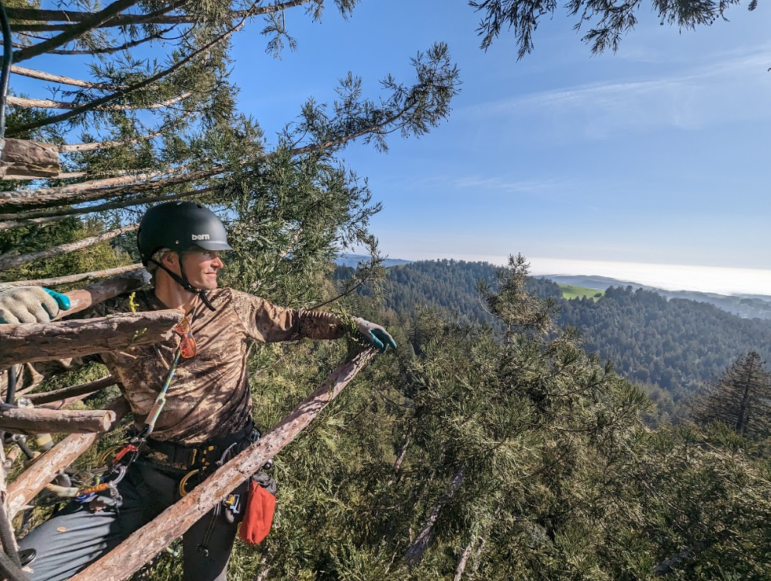
Mongabay founder Rhett Butler. Image: Courtesy of Mongabay
“That’s one of my favorite stories because it’s an example of bottom-up conservation in action,” says Butler. “The Indigenous community was getting nothing out of it besides protecting their ancestral forest, and the government recognized that. We knew the minister reads Mongabay regularly, so this was a rare, clear-cut connection between reporting and action.”
Mongabay has also developed a calendar system for discovering impacts and leads.
“Let’s say a freelancer or staff reporter does an investigation for us,” says Butler. “The editor will circle back with that reporter three, six, and 12 months after, and say ‘Hey, what’s happened since then?’ The reporter goes back to the source and organically surfaces the impact of the original story, and also may get more stories out of it. Everyone’s incentives are aligned with that system. That’s also good for funders to hear.”
Rolling out Mongabay Africa
Last year, Mongabay Africa was launched on the same model as Mongabay Latam, and it has roughly doubled in size in a year.
“Our current expansion in Africa is a big project, where we have also established partnerships with local media outlets and are hiring more contributors,” Butler explains. “Currently it’s in French and English, but we have ambitions to be more multilingual.”
Notable investigations from Mogabay’s increased recent focus on Africa include:
- A collaboration with El País and the Rainforest Investigations Network (RIN) revealing how Chinese-owned companies used “complaisance” permits to log and export a protected African hardwood, which was pushed to near-extinction in some countries.
- An investigation into effluent pollution and corporate impunity involving Zimbabwe’s largest lithium mine and a major dam.
- In-depth reporting on how a Canadian-South African mining company improperly secured mining rights in a war-torn region of the Democratic Republic of the Congo, to the cost of Indigenous communities and the local ecosystem.
- An investigation into illegal, industrial-scale fishing practices in Malagasy waters, which was closely followed by officials and the press in Madagascar, and which led to an investigation by the country’s fisheries chief.
Future Plans
“A year from now, we’d like to have a lot more capacity internally to work with primary data sources for investigations — whether that’s satellite imagery or a bioacoustics network or data from data scientists,” says Butler.
Mongabay’s seven-year plan includes five development “buckets”: editorial scale-ups and building a data studio; programs to reach new audiences; innovations for sustainability; enhanced safety for staff and sources; and training up environmental reporting beyond Mongabay.
“On audience reach, one important area is those communities most affected by climate change and environmental degradation, and thinking about how to do that more effectively,” he says. “Platforms like WhatsApp, for example. Also, we’re thinking about how we can cut across political divides — how do you frame a story to reach a conservative who may not believe in climate change?”
He adds: “We want to support local journalism in the markets where we report, as a duty, and also with an eye to some of those reporters becoming contributors to Mongabay one day.”

